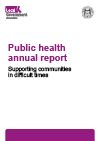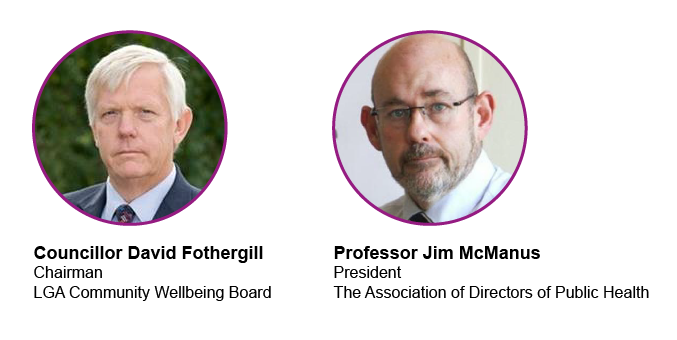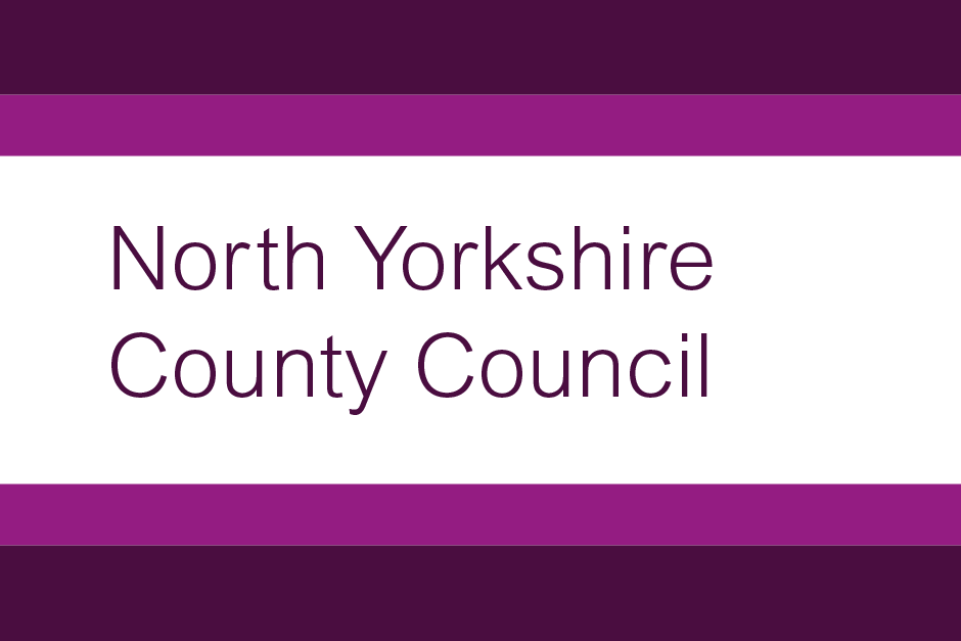
Foreword
We are pleased to introduce the eleventh Local Government Association (LGA) public health annual report, jointly published with the Association of Directors of Public Health (ADPH).
The public health annual reports trace the progress of public health in local government year-on year. They provide a valuable legacy which helps us to understand how far we have come and where we need to go.
Last year we published a milestone report Celebrating ten years of public health in local government. Directors of public health (DsPH) described the positive contribution of public health and councils in helping tackle the COVID-19 pandemic with the NHS and other local partners. There was widespread optimism that, despite the increase in health inequalities stemming from the pandemic, 2022 would be a time of recovery and renewal. In last year’s foreword we reflected that councils and their directors of public health “remain relentlessly positive about the potential to make a difference”.
The mood of this year’s annual report is significantly different. Public health teams remain positive because this is fundamental to their work, but this is often based in hope rather than optimism. Cost of living pressures are the second major health-related emergency in three years. They have the greatest impact on people who are least equipped to deal with financial challenges but also extends to a far larger population who would normally be able to manage without support. As well as the rising cost of living, a year of uncertainty about the direction of public health policy and the approach to tackling health inequalities has also blunted optimism.
Despite these pressures, this report demonstrates that councils, the NHS and the voluntary and community sector have upped their game once again to respond to a national challenge. Building on the experience of the pandemic, public health is at the forefront of each local response.
The broad range of measures being delivered to support people under financial pressure are described in this year’s case examples. We are proud of the work councils are doing to help people through the cost of living pressures. We are delighted that yet again the skills of public health, working with others, are proving so essential in driving and coordinating action to support local people.
A central theme in this report is that economic prosperity and health go hand in hand but the links between the two need to be much more widely understood and addressed through national policy and funding. There are challenging times ahead but if this is done, there is a window of opportunity to create healthy, sustainable places with a decent standard of living for all.
Introduction
Each year, an overall theme is chosen for the public health annual report and this year there was only one option – the cost of living pressures, its impact on health, and the role of public health in helping local areas to support people struggling with financial pressures.
As in previous years, this report includes case examples from eight councils across England covering both rural and urban environments, and with different levels and types of deprivation, affluence, health inequalities and population health needs. The report identifies key themes and thoughts about the future. It is based on interviews with DsPH, council chief executives, council leaders, lead members for health and wellbeing, ADPH and the LGA. Because this is a small sample, themes are indicative of the direction of travel and cannot be seen as representing how public health is involved in the cost of living pressures throughout England. However, as in previous years, there is a significant consistency in information which suggests that it presents a reasonable reflection of developments in most local councils up to December 2022.
Key messages
- The rising cost of living follows on from the COVID-19 pandemic having an impact on people’s health. People with least financial resilience are affected the most but increasing numbers of people who were previously ‘just about managing’ now need support.
- In many, if not most, councils, DsPH are the lead officers for coordinating arrangements across the council and with partners. This is because of their high-profile role in the pandemic and because their remit covers all key areas of cost of living support.
- Partnerships had been strengthened during the pandemic with deepened connections with communities and a coordinated focus on a single goal. Some councils have held multi-agency cost of living ‘summits’ to bring partners together. Most operate partnership arrangements to oversee progress across all the organisations involved.
- Many different organisations are involved in delivering cost of living support. The key strands of this are consistent across all areas:
- Information and advice – comprehensive information on websites and other media and face to face advice, such as increasing benefits take-up, in community settings.
- Warm welcome spaces in council and community venues providing a range of services from hot food to social activities to learning opportunities.
- Access to food – food partnerships are extending the work of food banks and other sources of low-cost food.
- The voluntary, community and faith sector and their volunteers sprang into action again to help with the rising cost of living. Organisations providing venues are also struggling with higher costs and many councils are providing grants to support their work. The sector is increasingly recognised as a foundational partner in delivery and strategic planning. Strengthening arrangements with the sector was a priority for all areas.
- Support often builds on interventions that have been established through public health in recent years – for example, making every contact count (MECC) initiatives and food partnerships.
- It is not clear when the cost of living pressures will end. Local partners are monitoring levels of need and support on an ongoing basis and will review the situation in the Spring.
- The rise in cost of living reinforces the link between health and prosperity. Local government understands that these are inextricably linked and is working on initiatives that consider these together. Greater recognition and action is needed at national level. Public health has a role in developing a clear narrative on the connection between work, education, training, and health.
- Public health is deeply engaged in work to reduce key health problems like obesity, and to tackle social determinants like poor housing, employment, infrastructure projects like active transport, and climate change. There is still huge untapped potential for making further progress through collaboration in these areas.
- After a promising start, with a national focus on levelling up and health inequalities, government churn and other factors meant that the year ended with a lack of a clear national policy direction.
- In last year’s public health annual report, the mood in public health was positive. This year there is concern that without adequate resourcing, all the hard work done to provide support will prove insufficient for the scale of the impact on health inequalities.
- The engagement of councils and public health by integrated care systems (ICSs) is mixed. Overall, the NHS is engaged in the cost of living agenda and is becoming more committed to tackling health inequalities, but this potential is not being fully realised because of the priority to improve elective and emergency care. While there is understanding of the pressures the NHS is facing, a medical approach to secondary prevention, focused on relieving immediate pressures, will do little to address health inequalities in the longer term. Failing to invest systematically in public health is a false economy which will increase pressures on the NHS and will impact on national prosperity. More needs to be done to support ICSs to work with local partners to focus on all aspects of prevention.
- Areas receiving levelling up or shared prosperity funding are optimistic this will result in improvements to health and health inequalities. Areas involved in devolution deals are similarly positive.
- Public health has an important advocacy role – speaking out for communities and for people facing health inequalities and reflecting the best evidence. Advocacy is important at local and national level to influence the health and wellbeing agenda.
Overview of 2022 – another highly challenging year
Last year’s public health annual report celebrated ten years of public health in local government. Just a year ago, the directors involved expressed optimism about the future. There was energy for moving beyond the pandemic and being able to build on the positive partnerships that were consolidated during the height of coronavirus to refocus on tackling the key health and wellbeing issues in their areas. There was also cautious optimism about the national policy of levelling up and that a forthcoming health disparities white paper would knit health more closely into the levelling up agenda.
This year the mood in directors has shifted from optimistic to ‘sombre’. While they are still positive about the future, the situation is highly challenging due to a range of factors.
Health protection and resilience challenges throughout the year
Alongside ongoing COVID-19 infections, this winter has seen high levels of flu across the country. There have also been outbreaks of Monkeypox, across England, but concentrated in and around London. Without additional resources, sexual health services were deployed in the vaccination efforts meaning reduced access to contraception and other services. Strep A was found in children across all regions, still rare but higher than in a typical year. Public health has been standing up its robust health protection services and working with NHS and other partners to identify and combat infections.
The impact of climate change is a growing challenge for many councils and is becoming a key public health priority. In the summer, the UK Health Security Agency (UKHSA) issued a succession of heat-health alerts and councils activated local heatwave plans due to extreme heat and record temperatures. Flooding affected some areas early in 2022 and again at the end of the year.
National political churn and inconsistent public health policies
The national political churn of three prime ministers, three secretaries of state for health and care, two secretaries of state for levelling up, housing and communities, and many changes of minister in both departments has contributed to the confusing state of national public health policy.
Publications include the Government Food Strategy for England, generally seen as a missed opportunity from a health perspective, and Making smoking obsolete, the government-commissioned review into tobacco control, welcomed by public health stakeholders but not yet responded to by government.
There were reversals in plans for reducing the consumption of food and drink high in fat, salt and sugar, with postponements in banning multi-buy deals and pre-watershed TV advertising. The levelling up policy, which included a mission to close the gap in healthy life expectancy, was welcomed by directors of public health, although they were also clear that it would take a whole-government approach to policy and investment to achieve this goal. The policy was suspended under Liz Truss, then reinstated, but the health disparities white paper promised to sit alongside it was not delivered.
Government announced that the Office for Health Improvement and Disparities (OHID) (which replaced Public Health England in October 2021) would drive action on improving the health of the population, prevention and tackling inequalities, including working with a new cross-ministerial board. OHID and the UKHSA continue to develop their work and local relationships.
On a positive note, Government allocated £50m for 13 Health Determinants Research Collaborations in which councils and universities will collaborate to improve understanding of what works to improve health inequalities. The LGA, ADPH and DsPH in previous annual reports have consistently called for an increase in research with practical applications.
In January 2023, the Health and Care Secretary announced that a Major Conditions Strategy would be produced to ‘alleviate pressure on the health system, as well as support the government’s objective to increase healthy life expectancy and reduce ill-health related labour market inactivity’. Indications are that the long-awaited gambling white paper will be published in March.
Integrated care boards (ICBs) and pressures on the NHS
In April, the Health and Care Act 2022 formally established the ICS structure of integrated care boards (ICBs) and integrated care partnerships (ICPs) and a requirement to publish integrated care strategies. The Act also set out new or strengthened duties for the NHS to reduce inequalities relating to access to services and health outcomes, to report on NHS action on inequalities, and to address health and wellbeing in decision making. (See the LGA’s Get in on the Health and Care Act 2022.)
The Integration white paper described how ICS digital population health management systems should include wider determinants of health such as homelessness and social isolation. The Government’s Mandate to the NHS 2022/23 included objective 4 (of 5) to ‘embed a population health management approach within local systems, stepping up action to prevent ill health and tackle health disparities’.
While the above set the scene for ICSs to help shape the system and place response to prevention and tackling health inequalities, the reality is very different. The NHS is under huge pressure to return to pre-COVID-19 levels of elective activity and improve accident and emergency, and ambulance performance, working with councils to tackle delayed discharges, exacerbated by years of underfunding and chronic staff shortages in adult social care. This leaves little bandwidth for developing prevention and early intervention. Involvement of councils in ICSs varies greatly, from those that feel positively engaged in a joint venture to others that feel peripheral to an agenda dominated by acute and crisis care.
There are also concerns in public health that if population health management focuses too much on the conditions people have already, rather than upstream prevention, this is a missed opportunity. Also, improved information about health needs must be supported by relevant interventions if it is to make a difference.
The cost of living pressures
The people most affected by financial pressures are those already facing health and other inequalities – both long-standing and exacerbated through the pandemic. However, all areas indicate that the population requiring support was growing to include people previously ‘just about managing’ – often people holding several jobs to build up an income that allowed them to cope. A growing area of concern is for people who have become economically inactive as a result of long-term health conditions such as long COVID, and as such are more vulnerable to rising costs. Directors wanted to stress that this affected everyone, but its impact was unequal – as with the pandemic it was a case of “same storm but different boats”.
Unsurprisingly, directors in areas with high levels of deprivation, low income and high health inequalities, were finding the greatest need for local support. Typically, these were urban councils or those covering coastal areas. Other areas reported a sense of worry and unease in communities which they expected would develop into need as the winter progressed through December and January. Large rural areas had specific concerns about the cost of fuel and difficulties of providing support to dispersed communities.
The LGA’s Cost of living hub contains case studies, resources and data to share good practice, covering topics including food insecurity, fuel poverty, and employment, plus news and updates through a cost of living bulletin.
Cost of living support – themes from case examples
DsPH are leaders and coordinators
In many if not most areas, DsPH have been charged with leading the coordination of action to support local people, some of which is delivered by public health, much by other colleagues. Directors were seen as well placed for this role because the remit of public health for the wider determinants of health crosses all the council functions with a role in cost of living. They had also proved their ability to effectively front high-profile local partnerships during the pandemic and were often at the forefront of developing collaborations with local communities.
Some areas had launched their cost of living work with community consultations and multi-sector events. This included mapping what support was available, identifying gaps, looking for synergies and reducing duplication to make every penny count. Launch events raised the profile of cost of living support with the local residents.
In most areas, arrangements to provide cost of living support were coordinated strategically by both a cross-council group and by a wider partnership group which includes key stakeholders such as the NHS, the voluntary, community and faith sector, housing partners and others. These were often led or linked by the Director of Public Health. Some are high profile groups chaired by local council leaders or mayors. In county councils, districts had a central role in delivering support.
Following a series of local community events in Cornwall over the summer, the Turning the Tide Summit of strategic and community leaders was convened by the DPH. The outcome of the summit was a statement from the leader of the council setting out seven cost of living commitments including food, fuel and increasing long-term prosperity.
Newham held a summit in September to share information and mobilise collective resources. A multi-agency cost of living taskforce, chaired by the Mayor, meets monthly to oversee the partnership response.
Cost of living interventions
There was considerable consistency in types of cost of living support undertaken in the case examples:
- information and advice
- warm welcome spaces
- access to low-cost food.
Information and advice
Coordinated, comprehensive information and advice was a central plank in all areas. Councils had often developed specific cost of living pages on the websites which were regularly updated with new information. Some areas were trying to ensure that all key sources of information provided consistent content and linked to each other. Councils were also reaching people through social media, specific cost of living campaigns, and leaflets and newsletters that were widely distributed through settings visited by the public, particularly council offices and community venues.
Councils with high levels of deprivation mentioned that one of their key aims was to make sure that people were receiving all the help and benefits to which they were entitled. Many areas had online benefits calculators and were also providing a range of personal support in community settings. In some areas, fuel advice was also an important priority.
Walsall operates an ‘advice from next door’ approach recognising that some people need support closer to home. The Walsall Connected approach means information has moved from a central one stop shop to seven local libraries and 18 community hubs which also help people to learn how to use the internet and online services.
In North Yorkshire, fuel poverty was identified as one of the main challenges facing people in the county, so public health increased investment in its fuel poverty advice contract with local Citizens Advice.
Some areas were building on existing Making Every Contact Count (MECC) initiatives, with staff and volunteers in many settings able to give brief cost of living advice.
Swindon’s Financial First Aiders programme uses the principle that ‘finance is everybody’s business’; training for frontline staff in brief conversations is provided by Citizens Advice Swindon.
Leicester’s MECC initiative, established with partners in the NHS, includes an initiative to develop an energy advice service involving training a large number of staff across many settings including neighbourhood centres.
Newham is carrying out proactive telephone winter welfare checks to reach vulnerable people who may not otherwise seek support. Newham Social Welfare Alliance which drives work on reducing poverty, has trained thousands of workers to provide brief interventions on social welfare topics such as income maximisation, debt advice and housing.
Warm welcome spaces
All areas were providing or supporting warm welcome spaces. These were generally a mix of council and community venues. Some were informal drop in spaces where people could come for a warm drink. Others provided an extensive range of support for people of all ages. In many areas, the number of warm spaces was increasing as more venues became involved. Many spaces were registered with the national warm welcome campaign.
Leicester’s 16 libraries are designated warm welcome spaces providing a range of services and support in neighbourhoods. This includes practical advice, workshops on financial and IT skills, job seeking advice with Department for Work and Pensions coaches, benefits checks, healthy living groups, activities for toddlers and study spaces for school children.
Cornwall’s community hubs, a partnership of over 50 voluntary sector organisations, working with the NHS and the council, are providing warm spaces, activities, access to practical information on money management, energy saving and benefits entitlement, social and practical activities including cooking skills and IT and signposting to further help. A new Community Gateway service has been established for support in people’s homes if they are not able to access community hubs.
Access to food
Public health is involved in the local food partnerships and networks that have been developing in recent years and were often further progressed in the pandemic as a way of increasing community resilience. Networks bring together organisations running local food banks and other sources of low-cost food to people on low incomes. Many areas report that sources of food are becoming more limited, while food banks are trying to increase their provision.
As well as supporting vulnerable people, networks also focus on the provision of healthy food in deprived neighbourhoods. Some cover wider issues, such as food production and sustainability. One small opportunity is an increased interest in low-cost heathy food, with areas providing cooking on a budget courses and cheaper ways of cooking. However, overall, the fear is that more people will be forced to buy cheaper, poor-quality food.
Newham Food Alliance involves over 40 organisations who provide surplus fresh food to people with the highest levels of need across the borough, including food banks and food parcels. It also provides hot meals to warm havens.
The Feeding Swindon Partnership is a legacy of collaborative work to improve food distribution and other support in the pandemic. One of the partners is the independent food bank, Swindon Food Collective, which feeds nearly 7,500 people a year. The collective has added three distribution centres since the summer. Other organisations provide food, including a range of food pantries that do not require referrals. Over the summer the council trialled giving 60 lower income families energy efficient slow cookers – the pilot proved successful and further approaches to low-cost cooking are being developed.
Lincolnshire has a highly active food partnership which works to promote all aspects of food related health, poverty and sustainability across the county, including information on community food growing and food banks.
The voluntary, community and faith sectors are vital strategic and delivery partners
Probably the strongest theme to emerge through this report was appreciation of the work of the voluntary, community and faith sectors and of individuals volunteering to help others. Without exception, contributors described how keen people and organisations were to help. New partnership mechanisms had been set up in the pandemic and were being used to deliver cost of living support. The sectors are valued for their ability to respond quickly, be innovative and make best use of resources. Councils recognise that community organisations with venues were also struggling with energy costs, and many are supporting them with additional grants.
In Blackpool the government’s Household Support Fund was augmented with funding from the NHS and the council to extend the pot available for a community grants programme. Grants of between £800 and £70,000 have been allocated for a range of services including extending food banks, access to hot meals, warm spaces, and activities.
North Yorkshire public health funds the council’s stronger communities team which works with 23 community support organisations that coordinate and mobilise voluntary and community support across the county.
Learning from the pandemic meant that Leicester restructured its ways of community engagement, including developing and supporting health and wellbeing champions and networks which are now helping with the cost of living response.
The future – rising cost of living and beyond
Monitoring response and future need
Supporting people is ongoing and fast moving and councils, with colleagues such as local Citizens Advice, regularly monitoring need and impact and adjusting support as required. Research on this report started in October and by completion in January 2023, areas had already extended support or started new initiatives. Many areas intended to undertake a comprehensive review in March to assess the winter response and identify next steps. One of the challenges is that no one knows when it will end. Contributors were generally of the view that it would extend through 2023 and next winter. There is concern that without additional resources, all the hard work done to provide support will prove insufficient for the scale of the impact on health inequalities.
In December, Blackpool organised a follow-up event to its cost of living launch to review the response so far, what else was needed, and to share good practice. For example
one organisation had organised a donated coat rack scheme with 300 coats given out in 10 days. A laundry facility set up by a community organisation was being used by many families and other organisations intend to replicate this. Unused community facilities were identified which could be occupied for additional activities.
Swindon set up a cost of living dashboard with as much real time data as possible including use of Swindon’s Household Support Fund and Emergency Assistance Fund and access to benefits. The dashboard is used to target messaging and prioritise action.
Cornwall’s Insights Dashboard contains key indicators populated by timely data which is used to influence strategic and operational decisions. For example, the dashboard collects data from Citizens Advice which shows that the most requested information is on household energy. Data from the Trussell Trust on food banks shows significant increases in usage from people in work, such as teaching assistants and home carers. This type of intelligence is used to influence the use of the Household Support Fund
Health and prosperity
The cost of living pressures have reinforced the focus on health inequalities, with gaps in healthy life expectancy a particular priority for some areas. The vital link between health and prosperity was raised by all directors. In some areas, public health was already working extremely closely with economic development and business colleagues on local economic inclusion, including regeneration projects. Dependent on the needs of local areas, public health was also focusing on other determinants, particularly education linked to prosperity, better housing and climate change.
Walsall’s DPH heads the council’s corporate Policy and Strategy Unit which includes production of strategies and action plans. Health, wellbeing and prosperity are at the heart of the strategic planning function and the strong connection between health and prosperity is hardwired into how the council operates.
Public health is a partner in Newham’s Community Wealth Building Strategy which aims to increase inclusive growth and investment, and this will be a key priority going forward.
Most areas had little cause for optimism about being able to undertake major health and wellbeing developments in the near future, but those accessing Shared Prosperity Funding and Levelling Up Funding were very positive about the potential for improving health and prosperity. Counties involved in devolution deals saw these as providing considerable opportunities for improving health.
Some of the coastal areas of Lincolnshire have received levelling up funding, including the Campus for Future Living at Mablethorpe, a partnership with the NHS, local universities and others which will be a centre of excellence for health and care training, technology and good practice. The DPH and lead councillor for care and health are working closely with this initiative to make sure that it makes the greatest difference to local health and prosperity.
Cornwall is planning a range of longer-term measures enabled by the County Deal and Shared Prosperity Fund to improve the quality of work opportunities including exploration of options to trial a basic income pilot across Cornwall. The Deal commits to Cornwall being an early adopter for public health innovations, with a vision for Cornwall to be a leading global healthy place to live.
Blackpool has a major problem with poor quality accommodation becoming houses in multiple occupation (HMOs), with associated neighbourhood problems like drug and alcohol use. The opportunity to build decent homes through Levelling Up Funding will have a big impact on health and wellbeing.
Prioritisation and NHS partnerships
Partnerships with the NHS were positive throughout, and there was a consistent view that the current rise in the cost of living was reinforcing the commitment of NHS colleagues to prioritise health inequalities. In some areas, the NHS had invested in place-based cost of living support. There was also appreciation of the huge demands on the NHS to improve emergency and elective care.
However, as in previous years of annual reports, there was concern that integrated care systems were overly focused on NHS recovery and provider organisations, rather than working with partners on prevention and health inequalities. Some DsPH felt engaged in their ICS and that progress was being made. Others felt there was little opportunity to influence an agenda focused on hospital care, so targeted their NHS partnership work to areas where they could make a difference, such as population health management. This meant they were able to direct more time and resources to areas where they could make the greatest impact on health inequalities, such as inclusive economic development or community resilience.
Community resilience
Developing community resilience remains a key priority for all areas, and voluntary, community and faith organisations are seen as an essential partner to reach and support the people most in danger of poor health. The voluntary and community sector is viewed as an essential strategic and delivery partner, not just in the cost of living pressures, but in the wider development of health and wellbeing strategies. However, areas were aware that it was important to maintain trust with the sector and communities it serves by supporting them in a fair and consistent way.
National changes that could make a difference
Contributors to the report were asked what national changes could better enable local government and partners to help people improve their health and to tackle health inequalities. Themes include the following:
- The link between health and prosperity needs to be explicitly understood at a national level. Public health has a role in developing a clear narrative on the link between education, work and health to influence the national agenda. Prosperity should not be mainly measured by economic growth but by a wide range of factors including health and wellbeing. This shift should be reflected in all national policies, decision-making and investment.
- Councils and public health need sufficient funding which can be used flexibly for local needs; they need longer-term settlements – at least five years.
- The national approach to funding should better recognise that some people are disproportionately vulnerable and that tackling inequalities requires more resources.
- Councils would benefit from greater freedoms, such as being able to establish local health and wellbeing criteria for licensing and planning decisions.
- There should be a clear national public health policy based on evidence-based policies in areas such as heath and prosperity, food and obesity, and smoking reduction.
- ICSs should be supported to work with local government on prevention and the wider determinants of health as well as NHS priorities.
- Public health should develop its advocacy and lobbying role to raise the profile of key issues in health and wellbeing.









